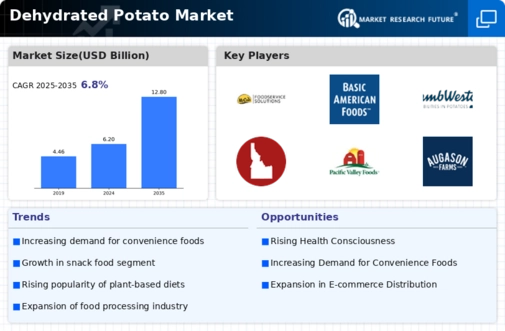Market Analysis
In-depth Analysis of Dehydrated Potato Market Industry Landscape
The dehydrated potato market has experienced noteworthy trends in recent years, reflecting changing consumer preferences, global food consumption patterns, and advancements in food technology. One significant trend is the increasing demand for convenience and shelf-stable food products, driving the popularity of dehydrated potatoes. Dehydrated potatoes offer a convenient solution for consumers seeking quick and easy meal options without compromising on nutritional value. The long shelf life of dehydrated potatoes makes them a practical choice for both consumers and food manufacturers, aligning with the busy lifestyles of modern households.
Health and wellness considerations are influencing the dehydrated potato market. As consumers become more health-conscious, there is a growing interest in nutritious and minimally processed food options. Dehydrated potatoes retain many of the nutrients found in fresh potatoes, providing a source of vitamins, minerals, and fiber. This trend is particularly relevant as consumers seek to balance convenience with their desire for wholesome and nutrient-dense food choices.
The market is witnessing diversification in dehydrated potato products, catering to a variety of culinary preferences. Dehydrated potato flakes, granules, slices, and dices are now available, offering versatility to both home cooks and food manufacturers. This trend is driven by the desire for diverse applications, from quick mashed potatoes to soups, stews, and snack products. The availability of different forms of dehydrated potatoes enhances their usage in a wide range of recipes, contributing to their popularity in the food industry.
Globalization and the influence of international cuisines are impacting the dehydrated potato market. As consumers explore diverse culinary traditions, the demand for dehydrated potatoes in various global dishes is on the rise. This trend is evident in the use of dehydrated potatoes in international recipes, such as Spanish tortillas, Indian curries, and Japanese potato croquettes. Food manufacturers are capitalizing on this trend by offering dehydrated potatoes with specific textures and flavor profiles that align with different cuisines.
The market is responding to sustainability concerns by promoting efficient resource utilization in the production of dehydrated potatoes. Dehydrated potatoes require less storage space and transportation compared to fresh potatoes, leading to reduced energy consumption and lower carbon emissions. This aligns with the growing emphasis on sustainable practices in the food industry, making dehydrated potatoes an eco-friendly option for both consumers and manufacturers.
E-commerce is playing a crucial role in the dehydrated potato market, providing consumers with convenient access to a wide range of products. The online retail platform allows consumers to explore different brands, compare prices, and read reviews, facilitating informed decision-making. This trend is particularly relevant in regions where access to specialty or dehydrated potato products may be limited in traditional brick-and-mortar stores.
Despite the positive trends, challenges exist in terms of consumer perception and competition from fresh potatoes. Some consumers may perceive dehydrated potatoes as less nutritious or less flavorful compared to fresh alternatives. Overcoming these perceptions requires effective marketing strategies that emphasize the convenience, nutritional value, and versatility of dehydrated potatoes. Additionally, the market faces competition from fresh potatoes, as some consumers prefer the sensory experience of preparing and consuming fresh produce.










Leave a Comment